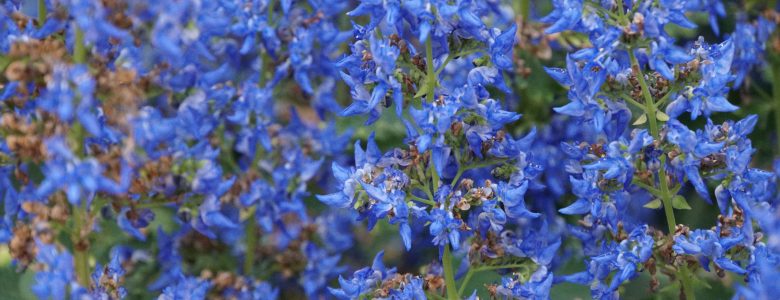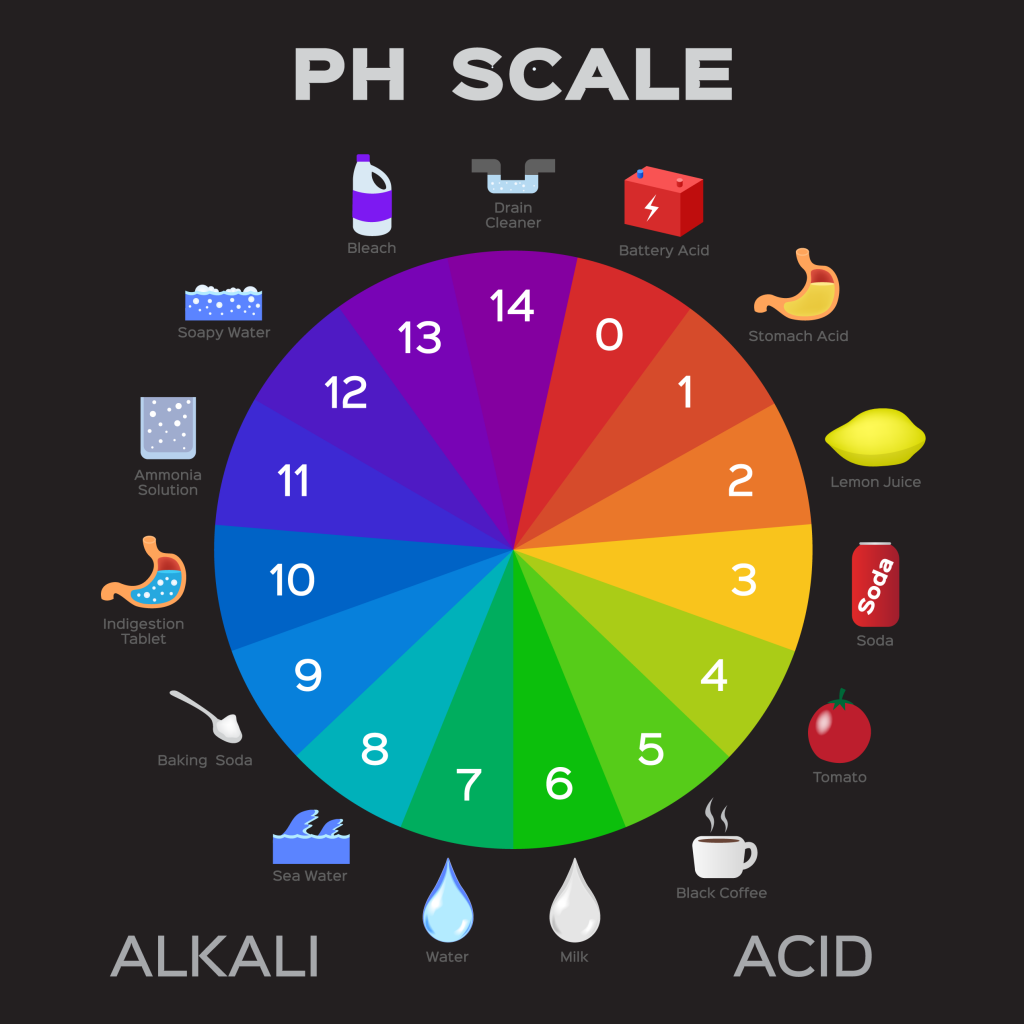April 30, 2020
The Science Behind Blue Flowers

By: burgundy bug
An abundance of dainty, blue flowering plants
Source: Blue & Purple Flowers | Penelope Peru Photography
Blue is all around us, from the oceans to their reflection in the sky, but it’s very rare that you’ll see blue anywhere else in nature – unless you’re flipping through a Dr. Seuss book.
Wildflowers sporting a bluish-hue, which includes purple and violet flowers, only account for about 15 to 20 percent of all flower colors, says a 2018 Breeding Science journal review.
“Many ornamental plants with a high production volume, such as rose and chrysanthemum, lack the key genes for producing the blue delphinidin pigment or do not have an intracellular environment suitable for developing blue color,” the review explains.
While recent advancements in genetic engineering have allowed scientists to synthesize blue roses, chrysanthemums, orchids, and dahlias, the process isn’t as simple as “editing a few genes” (granted, gene editing isn’t such a simple process, either).
The Science Behind Flower Colors
A sunset-colored orchid with petals displaying yellow, orange, and hot-pink hues
Source: Orchids 05 | Penelope Peru Photography
According to a 2015 Frontiers in Plant Science study, the color of a flower is determined by multiple factors, including:
- Petal tissue structure
- Pigment types and distribution
- pH
- Environmental temperature
- Lighting
- Watering frequency
- Mineral nutrients
- Plant hormones
- Genes
How deep the pigments are distributed throughout the layers of the petal and the shape of the petal cells affect the lightness and saturation of a flower’s color.
Generally speaking, pigments are distributed in the upper epidermis of a petal, but pigments can be distributed in the lower epidermis of darker flower petals.
Flat petal cells reflect more light, resulting in a lighter colored flower. By contrast, conical cells “enhance the light absorption by pigments, thereby leading to darkened flower color and enhanced color saturation,” the study explains.
Pigment types can fall into three main categories: carotenoids, alkaloids, and flavonoids.
“Carotenoids are the most widely distributed pigments in nature,” the study says. “In addition to flowers, they can also be found in fruits, leaves, and roots in higher plants.”
These pigments absorb colors of shorter wavelengths – blues and violets – thus, they reflect shades of bright red, orange, and yellow.
The wavelengths of visible colors: red wavelengths are the longest, violet wavelengths are the shortest
Source: Adobe Stock
“A solid object has color depending on the light it reflects,” explains an article by University of Illinois professor Patricia Shapley. “If it absorbs light in the red and yellow region of the spectrum, it will have a blue color.”
To break it down further, the Frontiers in Plants Science study demonstrates how different carotenoids determine whether a flower will lean more towards red and orange, or yellow.
Alkaloids play a role in flower color development, as well. The presence of one alkaloid over another determines what color a flower will be – and if both of the alkaloids are present, a hybrid emerges.
For example, “the difference between a flower being red or yellow depends on the presence of betacyanin or betaxanthin in the petals,” the study says. “Orange to red or variegated colors may be produced if both pigments co-exist in a flower.”
Flavonoids are the heart of color variety and produce a spectrum of colors ranging from pale-yellow to blue-purple. They can vary significantly among plants within the same species, allowing the same species to show off an array of uniquely colored flowers.
Anthocyanin is a flavonoid responsible for the development of most colors, but they’re highly unstable. Environmental factors like pH levels, temperature, lighting, watering frequency, and mineral nutrients can alter the biosynthesis and distribution of anthocyanin, causing the same plant to bloom in different shades depending on how it’s cared for.
Different genes also regulate flower color development, affecting the regulation of anthocyanin.
The Quest For Producing Blue Flowers
An artistic collage of blue flowers
Source: Adobe Stock
Researchers have successfully attempted to achieve a perfect balance between the aforementioned factors to create blue flowers.
In particular, scientists have tried introducing a gene that promotes the synthesis of anthocyanin delphinidin, which is seen to produce blue flowers in plants where it naturally occurs, the Breeding Science journal review explains.
However, they couldn’t just introduce this gene into roses, chrysanthemums, and other plants that aren’t naturally blue; they also had to sustain the right conditions for blue coloration.
“The production of delphinidin-based anthocyanins alone is not sufficient for blue coloration,” the review explains.
“To develop blue-coloration, it is necessary to modify the environment where delphinidin-based anthocyanins are present.”
Recent Advances in the Research and Development of Blue Flowers | Breeding Science
The environmental factors needed to produce blue flowers will also vary among different plant species.
“To express blue coloration [in roses], it is important to introduce genes that can create a weakly acidic pH of about 5.6 to 6.2, or to use strains or cultivars that naturally exhibit a relatively higher pH,” the review explains.
While roses require petal cells with pH levels of 5.6 to 6.2 to bloom in blue, hydrangea flowers develop in pH levels four to five.
The pH scale with examples of the pH levels in common foods and liquids
Source: Adobe Stock
When deciding which cultivar is worth turning blue, researchers have to assess its regeneration and transformation – the ability for it to renew and repair its tissue as well as the cultivar’s ability to genetically transform.
Furthermore, a blue-flower can’t hit the shelves of plant nurseries immediately after being bred.
“Genetically modified flowers have to pass the risk-assessments mandated in international protocols and/or government regulations and policies for cultivation, distribution, and retail,” the study says. “In order to grow and sell flowers in an open environment, it is necessary to prove that the risk to the ecology, including the possibility for gene flow into related wild species and influence on unspecified organisms, is minimized.”
In the case of genetically engineered blue chrysanthemums being commercialized in Japan, the flowers will have to be engineered to be sterile to prevent impacting the wild chrysanthemums that are native to Japan and Eastern Asia.
In Conclusion
Dainty, blue colored flowers
Source: Blue Flowers | Penelope Peru Photography
Breeding different colored flowers is akin to mixing paint. Just like paint color is affected by the canvas, whether it’s being diluted with water, and how dry it is, flower colors are influenced by their own set of environmental factors.
Blue colored flowers are a rarely occurring natural phenomena, but damn if humans won’t do everything to try changing that.
Call it commercialization, or downright curiosity, but researchers have spent years trying to genetically engineer the conditions for blue flowers in species that otherwise would never be blue.
The science behind it has developed rapidly in recent years and has reached a point where researchers have successfully created blue flowers in multiple species where it was once deemed “impossible” to do so.
Nonetheless, it could still be a few years before blue flowers are widely available to consumers, as the plants have to undergo a series of assessments to ensure they’re not a threat to the environment.
Interested in having content featured in an upcoming blog post or issue of The Burgundy Zine? Head on over to the submissions page!
For all other inquiries, please fulfill a contact form.







